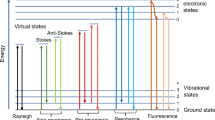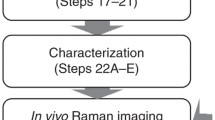Abstract
Raman spectroscopy exhibits potential as a tool for identifying the chemical composition of substances and has witnessed a growing application in urological oncology. This study undertook a bibliometric analysis to chart the present state and future prospects of Raman spectroscopy applications in urological tumors. The present study retrieved literature on the utilization of Raman spectroscopy in urological oncology from the Science Citation Index Expanded of Web of Science Core Collection, spanning from its inception to June 2023. Data from included studies were analyzed using CiteSpace, Python, and Excel. Our study examined 897 articles from 65 countries and identified a significant exponential growth in annual publications. The USA and China were prominent contributors to this field, with high publication rates and funding agencies. Shanghai Jiao Tong University emerged as the most influential institution. The journals Analytical Chemistry and Analyst were found to be the most productive. Our keyword analysis revealed an intense interest for “gold nanoparticle” and “pathology,” with the most recent bursts occurring for “surface-enhanced Raman scattering (SERS),” “biomarkers,” and “prostate specific antigen.” As a detection tool, Raman spectroscopy holds the potential to assist in the identification, management, and prognostication of urological tumors. Notably, adjuvant diagnosis and prognosis evaluation based on SERS of tumor markers is a hot research topic. These findings offer valuable insights into the current state of Raman spectroscopy research in urological oncology, which could inform future studies and clinical practice.





Similar content being viewed by others
Data Availability
Data are available from the corresponding author if justification for the requirement is justified.
References
Raman CV, Krishnan KS (1928) A new type of secondary radiation. Nature 121(3048):501–502
Kneipp K, Kneipp H, Itzkan I, Dasari RR, Feld MS (1999) Ultrasensitive chemical analysis by Raman spectroscopy. Chem Rev 99(10):2957–2976
Liang Z, Wu J, Cui Y, Sun H, Ning CZ (2023) Self-optimized single-nanowire photoluminescence thermometry. Light Sci Appl 12(1):36
Cutshaw G, Uthaman S, Hassan N, Kothadiya S, Wen X, Bardhan R (2023) The emerging role of Raman spectroscopy as an omics approach for metabolic profiling and biomarker detection toward precision medicine. Chem Rev 123(13):8297–8346
Dodo K, Fujita K, Sodeoka M (2022) Raman spectroscopy for chemical biology research. J Am Chem Soc 144(43):19651–19667
Gomella PT, Mark JR, Giri VN, Kelly WK, Gomella LG (2022) Guidelines on germline testing for urologic tumor syndromes. Eur Urol Focus 8(3):670–673
Hanchanale VS, Rao AR, Das S (2008) Raman spectroscopy and its urological applications. Indian J Urol 24(4):444–450
Liu Z, Zhang P, Wang H et al (2022) Raman spectrum-based diagnosis strategy for bladder tumor. Urol Int 106(2):109–115
Moed HF (2009) New developments in the use of citation analysis in research evaluation. Arch Immunol Ther Exp (Warsz) 57(1):13–18
Benie-Bi J, Cambon L, Grimaud O, Kivits J, Alla F (2013) Health needs and public health functions addressed in scientific publications in Francophone sub-Saharan Africa. Public Health 127(9):860–866
Donthu N, Kumar S, Mukherjee D, Pandey N, Lim WM (2021) How to conduct a bibliometric analysis: an overview and guidelines. J Bus Res 133:285–296
Shirkhorshidi AS, Aghabozorgi S, Wah TY, Herawan T (2014) Big Data clustering: a review. In: Murgante B, et al (ed) Computational Science and Its Applications – ICCSA 2014. ICCSA 2014. Lecture Notes in Computer Science, vol 8583. Springer, Cham. https://doi.org/10.1007/978-3-319-09156-3_49
Lü L, Zhou T, Zhang QM, Stanley HE (2016) The H-index of a network node and its relation to degree and coreness. Nat Commun 7:10168
Crow P, Barrass B, Kendall C et al (2005) The use of Raman spectroscopy to differentiate between different prostatic adenocarcinoma cell lines. Br J Cancer 92(12):2166–2170
Crow P, Molckovsky A, Stone N, Uff J, Wilson B, WongKeeSong LM (2005) Assessment of fiberoptic near-infrared Raman spectroscopy for diagnosis of bladder and prostate cancer. Urology 65(6):1126–1130
Roman M, Wrobel TP, Panek A, Paluszkiewicz C, Kwiatek WM (2020) Lipid droplets in prostate cancer cells and effect of irradiation studied by Raman microspectroscopy. Biochim Biophys Acta Mol Cell Biol Lipids 1865(9):158753
Roman M, Wrobel TP, Panek A, Paluszkiewicz C, Kwiatek WM (2021) Exploring subcellular responses of prostate cancer cells to clinical doses of X-rays by Raman microspectroscopy. Spectrochim Acta A Mol Biomol Spectrosc 255:119653
Wang Q, Cui T, Deng P (2022) Medicine-engineering interdisciplinary research based on bibliometric analysis: a case study on medicine-engineering institutional cooperation of Shanghai Jiao Tong University. J Shanghai Jiaotong Univ Sci 1–16. https://doi.org/10.1007/s12204-022-2418-5
Small H, Griffith BC (1974) The structure of scientific literatures I: identifying and graphing specialties. Sci Stud 4(1):17–40
Yu C, La W (2015) The methodology function of CiteSpace mapping knowledge domains. Studies in Science of Science.
Qiao H, Sun H, Li J et al (2017) Structure, intrinsic properties and vibrational spectra of Pr(Mg1/2Sn1/2)O3 ceramic crystal. Sci Rep 7(1):13336
Schatz GC, Young MA, Van Duyne RP (2006) Electromagnetic Mechanism of SERS. In: Kneipp K, Moskovits M, Kneipp H (eds) Surface-Enhanced Raman Scattering. Topics in Applied Physics, vol 103. Springer, Berlin, Heidelberg, pp 19–46. https://doi.org/10.1007/3-540-33567-6_2
Zhou Y, Lu Y, Liu Y, Hu X, Chen H (2023) Current strategies of plasmonic nanoparticles assisted surface-enhanced Raman scattering toward biosensor studies. Biosens Bioelectron 228:115231
Ivankova V, Gavurova B, Khouri S (2022) Understanding the relationships between health spending, treatable mortality and economic productivity in OECD countries. Front Public Health 10:1036058
Papanicolas I, Woskie LR, Jha AK (2018) Health care spending in the United States and other high-income countries. Jama 319(10):1024–1039
de Jong BW, Schut TC, Maquelin K et al (2006) Discrimination between nontumor bladder tissue and tumor by Raman spectroscopy. Anal Chem 78(22):7761–7769
Cauberg EC, de Bruin DM, Faber DJ, van Leeuwen TG, de la Rosette JJ, de Reijke TM (2009) A new generation of optical diagnostics for bladder cancer: technology, diagnostic accuracy, and future applications. Eur Urol 56(2):287–296
Bensalah K, Fleureau J, Rolland D et al (2010) Raman spectroscopy: a novel experimental approach to evaluating renal tumours. Eur Urol 58(4):602–608
Cheng Z, Choi N, Wang R et al (2017) Simultaneous detection of dual prostate specific antigens using surface-enhanced Raman scattering-based immunoassay for accurate diagnosis of prostate cancer. ACS Nano 11(5):4926–4933
Zhou W, Gao X, Liu D, Chen X (2015) Gold nanoparticles for in vitro diagnostics. Chem Rev 115(19):10575–10636
Shapiro A, Gofrit ON, Pizov G, Cohen JK, Maier J (2011) Raman molecular imaging: a novel spectroscopic technique for diagnosis of bladder cancer in urine specimens. Eur Urol 59(1):106–112
Del Mistro G, Cervo S, Mansutti E et al (2015) Surface-enhanced Raman spectroscopy of urine for prostate cancer detection: a preliminary study. Anal Bioanal Chem 407(12):3271–3275
Yim K, Ma C, Carlsson S et al (2023) Free PSA and clinically significant and fatal prostate cancer in the PLCO screening trial. J Urol 210(4):630–638
Barry MJ (2001) Clinical practice. Prostate-specific-antigen testing for early diagnosis of prostate cancer. N Engl J Med 344(18):1373–1377
Chen N, Rong M, Shao X et al (2017) Surface-enhanced Raman spectroscopy of serum accurately detects prostate cancer in patients with prostate-specific antigen levels of 4-10 ng/mL. Int J Nanomedicine 12:5399–5407
Ma TK, Szeto CC (2012) Mineralocorticoid receptor antagonist for renal protection. Ren Fail 34(6):810–817
Zacharovas E, Velička M, Platkevičius G et al (2022) Toward a SERS diagnostic tool for discrimination between cancerous and normal bladder tissues via analysis of the extracellular fluid. ACS Omega 7(12):10539–10549
Pan J, Shao X, Zhu Y et al (2019) Surface-enhanced Raman spectroscopy before radical prostatectomy predicts biochemical recurrence better than CAPRA-S. Int J Nanomedicine 14:431–440
Kar S, Jaswandkar SV, Katti KS et al (2022) Label-free discrimination of tumorigenesis stages using in vitro prostate cancer bone metastasis model by Raman imaging. Sci Rep 12(1):8050
Qian H, Wang Y, Ma Z et al (2022) Surface-enhanced Raman spectroscopy of pretreated plasma samples predicts disease recurrence in muscle-invasive bladder cancer patients undergoing neoadjuvant chemotherapy and radical cystectomy. Int J Nanomedicine 17:1635–1646
Naief MF, Khalaf YH, Mohammed AM (2022) Novel photothermal therapy using multi-walled carbon nanotubes and platinum nanocomposite for human prostate cancer PC3 cell line. J Organomet Chem 975:122422
Bertorelle F, Pinto M, Zappon R et al (2018) Safe core-satellite magneto-plasmonic nanostructures for efficient targeting and photothermal treatment of tumor cells. Nanoscale 10(3):976–984
Pinto M, Zorn KC, Tremblay JP et al (2019) Integration of a Raman spectroscopy system to a robotic-assisted surgical system for real-time tissue characterization during radical prostatectomy procedures. J Biomed Opt 24(2):1–10
Tan PH, Cheng L, Srigley JR et al (2011) International society of urological pathology (ISUP) consensus conference on handling and staging of radical prostatectomy specimens. Working group 5: surgical margins. Mod Pathol 24(1):48–57
Briganti A, Gallina A, Suardi N et al (2010) Predicting erectile function recovery after bilateral nerve sparing radical prostatectomy: a proposal of a novel preoperative risk stratification. J Sex Med 7(7):2521–2531
Suardi N, Moschini M, Gallina A et al (2013) Nerve-sparing approach during radical prostatectomy is strongly associated with the rate of postoperative urinary continence recovery. BJU Int 111(5):717–722
Yao L, Hui L, Yang Z, Chen X, Xiao A (2020) Freshwater microplastics pollution: detecting and visualizing emerging trends based on CiteSpace II. Chemosphere. 245:125627
Author information
Authors and Affiliations
Contributions
QH and ZT: study design, writing, data analysis, drafting article.
DC and HL: critical revision of article.
LZ: critical revision of article, approval of article.
Corresponding author
Ethics declarations
Informed consent
Informed consent is not applicable.
Competing interests
The authors declare no competing interests.
Additional information
Publisher’s Note
Springer Nature remains neutral with regard to jurisdictional claims in published maps and institutional affiliations.
Supplementary information
ESM 1
(DOCX 184 kb)
Rights and permissions
Springer Nature or its licensor (e.g. a society or other partner) holds exclusive rights to this article under a publishing agreement with the author(s) or other rightsholder(s); author self-archiving of the accepted manuscript version of this article is solely governed by the terms of such publishing agreement and applicable law.
About this article
Cite this article
He, Q., Tan, Z., Chen, D. et al. Advancements and prospects of Raman spectroscopy in urological tumors: a bibliometric analysis. Lasers Med Sci 38, 230 (2023). https://doi.org/10.1007/s10103-023-03897-w
Received:
Accepted:
Published:
DOI: https://doi.org/10.1007/s10103-023-03897-w




